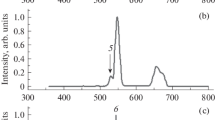Abstract
The complex dielectric constant of KBr single crystals doped with KOH and with KOD has been measured in the temperature range from 0.32°K to 300°K using a small a. c. signal. A relaxation timeτ 0 was determined by means of Cole-Cole plots. ForT<4°K the temperature dependence ofτ 0 can be approximated byAT −n, wheren is between 1.2 and 1.3 for the dilute samples, and between 0.8 and 1.0 for two samples with large hydroxyl concentrations.n has the same value for OH− and OD− dipoles. The constantA roughly doubles upon substitution ofH byD. The relaxation behavior was found to be independent of concentration in the range between 3×1018 cm−3 dipoles and 1019 dipoles cm−3.
Zusammenfassung
Die komplexe Dielektrizitätskonstante von KBr Einkristallen mit Zusätzen von KOH und von KOD wurde im Temperaturbereich von 0,32°K bis 300°K gemessen. Die häufigste Relaxationszeitτ 0 wurde aus Cole-Cole Diagrammen bestimmt. Unterhalb 4°K kannτ 0 durch die Funktionτ 0=AT −n beschrieben werden. Für stark verdünnte Präparate liegt der Exponentn zwischen 1,2 und 1,3 während für zwei Proben mit großen Hydroxylkonzentrationenn einen Wert zwischen 0,8 und 1,0 hat. Der Exponentn hängt nicht von der Art des Hydroxylions ab. Die KonstanteA ist für KBr: OH− um ungefähr einen Faktor 2 kleiner als für KBr: OD−. Im Konzentrationsbereich von 3·1018 Dipole cm−3 bis 1019 Dipole cm−3 ist die Relaxationszeitτ 0 konzentrationsunabhängig.
Résumé
On a mesuré la constante diélectrique complexe de monocristaux de KBr dopé au KOH et au KOD pour des températures variant de 0,32°K à 300°K.
Le temps de relaxation le plus probable,τ 0, est déterminé à partir des diagrammes Cole-Cole. Au dessous de 4°K,τ 0 peut être représenté par la fonctionτ 0=A·T −n. Pour les cristaux faiblement dopés,n varie entre 1,2 et 1,3; pour deux cristaux à forte concentration d'ions hydroxyles on a trouvé pourn des valeurs entre 0,8 et 1,0.n est indépendant du genre d'ion hydroxyle. La valeur de la constanteA se double environ lorsqu'on passe du KBr: OH− au KBr: OD−. Pour des concentrations variant de 3·1018 dipoles cm−3 à 1019 dipoles cm−3 le temps de relaxationτ 0 est indépendant de la concentration.
Similar content being viewed by others
References
Kuhn, U., andF. Lüty: Solid State Comm.2, 281 (1964).
Känzig, W., H. R. Hart, andS. Roberts: Phys. Rev. Letters13, 543 (1964).
Lüty, F.: J. de Physique28, Colloque C 4, (1967).
Bosshard, U., R. W. Dreyfus, andW. Känzig: Phys. kondens. Materie4, 254 (1964).
Schaerer, L. D., andT. L. Estle: Solid State Comm.4, 639 (1966).
Cole, K. S., andR. H. Cole: J. Chem. Phys.9, 341 (1941).
Similar treatments are given in text books, as for example Hb. d. Physik XIII 1956, P. 119, byW. F. Brown, Jr. Berlin-Göttingen-Heidelberg: Springer.
Debye, P.: Polar Molecules, Chemical Catalog. Chap. V. New York 1929.
Devonshire, A. F.: Proc. Roy. Soc.A 153, 601 (1936).
Sauer, P., O. Schirmer, andJ. Schneider: Phys. Stat. Sol.16, 79 (1966).
Shore, H. B.: Phys. Rev.151, 570 (1966).
Pfister, G.: Helv. Phys. Acta39, 602 (1966).
Baur, M. E., andW. R. Salzmann: Phys. Rev.151, 710 (1966)
Höcherl, G., D. Blumenstock, andH. C. Wolf: Phys. Letters24 A, 511 (1967).
Bosomworth, D. R.: Solid State Comm.5, 681 (1967).
Silsbee, R. H.: J. Phys. Chem. Solids28, 2525 (1967).
Pfister, G.: Thesis (to be published).
Zernick, W.: Phys. Rev.139, A 1010 (1965).
Brout, R.: Phys. Rev. Letters14, 175 (1965).
Klein, M.: Phys. Rev.141, 489 (1966).
Lawless, W. N.: Phys. Kondens. Materie5, 100 (1966).
——: Phys. Rev. Letters17, 1048 (1966).
Zernick, W.: Phys. Rev.158, 562 (1967).
Baur, M. E., andW. R. Salzmann, Phys. Rev. Letters18, 590 (1967).
Lawless, W. N.: J. Phys. Chem. Solids28, 1755 (1967).
Sussmann, J. A.: Phys. kondens. Materie2, 146 (1964).
Pirc, P., B. Zeks, andP. Gosar: J. Phys. Chem. Solids27, 1219 (1966).
Landau, L. D., andF. M. Lifschitz: Quantenmechanik, S. 183. Berlin: Akademie-Verlag 1965.
Author information
Authors and Affiliations
Rights and permissions
About this article
Cite this article
Knop, K., Pfister, G. & Känzig, W. Dielectric relaxation of KBr doped with KOH and KOD. Phys kondens Materie 7, 107–116 (1968). https://doi.org/10.1007/BF02422897
Received:
Issue Date:
DOI: https://doi.org/10.1007/BF02422897




